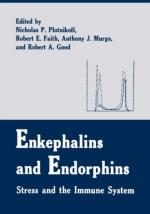|
This section contains 289 words (approx. 1 page at 300 words per page) |
Endorphins are a group of peptides with potent ANALGESIC properties that occur naturally in the brain. The word endorphin is a contraction for the words end ogenous and morphine; it was coined by narcotics researchers in 1975 as the preferred term for a then hypothetical natural substance capable of action at RECEPTORS for OPIATES (such as HEROIN). The underlying hypothesis was that an endorphin NEUROTRANSMITTER utilized the receptors at which morphine and related drugs exerted their actions. After extensive and intensely competitive research by many groups, three distinct types of such endogenous opioid peptides were found (peptides are segments of linked amino acids that can act as neurotransmitters). By 1999, additional peptides able to act at opioid receptors as well as to regulate pain sensitivity through nonopioid receptors had been identi-fied.
Each type of opioid peptide gives rise to one or more opioid peptide prohormones, which are then modified by enzymes in tissues to convert the larger inactive peptides into smaller active ones. For example, the pro-opiomelanocortin prohormone is synthesized in the corticotropes in the anterior pituitary gland and separately in hypothalmic and medullary neurons is cleaved in those cells to β-endorphin, a 31 amino-acid peptide with the greatest intrinsic opioid activity. Each active natural opioid peptide contains the tetrapeptide tyrosineglycine-glycine-phenylalanine at its amino terminus. The fifth amino acid is either methionine (resulting in the so-called Met5 enkephalin) or leucine (resulting in leu-enkephalin). Opioid peptides derived from plants—for example, caseimorphin—have also been described. The opioid peptides, of which the proenkephalin-and prodynorphin-derived peptides are most widespread, are found in specific neurons in the brain.
See Also
Bibliography
COOPER, J. R., BLOOM, F. E., & ROTH, R. H. (1996). The biochemical basis of neuropharmacology, 7th ed. New York: Oxford University Press.
|
This section contains 289 words (approx. 1 page at 300 words per page) |


